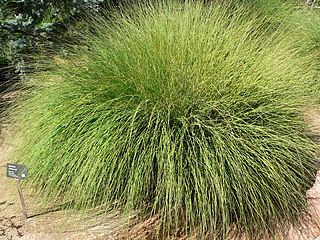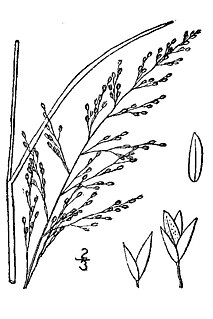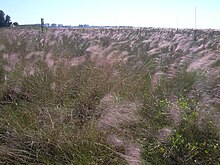
A basket is a container that is traditionally constructed from stiff fibers and can be made from a range of materials, including wood splints, runners, and cane. While most baskets are made from plant materials, other materials such as horsehair, baleen, or metal wire can be used. Baskets are generally woven by hand. Some baskets are fitted with a lid, while others are left open on top.

Cynodon is a genus of plants in the grass family. It is native to warm temperate to tropical regions of the Old World, as well as being cultivated and naturalized in the New World and on many oceanic islands.

Xerophyllum tenax is a North American species of plants in the corn lily family. It is known by several common names, including bear grass, squaw grass, soap grass, quip-quip, and Indian basket grass.

Basket weaving is the process of weaving or sewing pliable materials into three-dimensional artifacts, such as baskets, mats, mesh bags or even furniture. Craftspeople and artists specialized in making baskets may be known as basket makers and basket weavers. Basket weaving is also a rural craft.

Muhlenbergia schreberi, the nimblewill, is a grass species native to North America.

Hierochloe odorata or Anthoxanthum nitens is an aromatic herb native to northern Eurasia and North America. It is a sacred grass of the indigenous peoples of Canada and the United States. It is used as a smudge, in herbal medicine and in the production of distilled beverages. It owes its distinctive sweet scent to the presence of coumarin.

Muhlenbergia rigens, commonly known as deergrass, is a warm season perennial bunchgrass. It is found in sandy or well-drained soils below 7,000 feet (2,100 m) in elevation in the Southwestern United States and parts of Mexico.

McLeod Plantation is a former forced-labor plantation located on James Island, South Carolina, near the intersection of Folly and Maybank roads at Wappoo Creek, which flows into the Ashley River. The plantation is considered an important Gullah heritage site, preserved in recognition of its cultural and historical significance to African-American and European-American cultures.
Sweet grass or sweetgrass may refer to:

Muhlenbergia is a genus of plants in the grass family.

Tussock grasses or bunch grasses are a group of grass species in the family Poaceae. They usually grow as singular plants in clumps, tufts, hummocks, or bunches, rather than forming a sod or lawn, in meadows, grasslands, and prairies. As perennial plants, most species live more than one season. Tussock grasses are often found as forage in pastures and ornamental grasses in gardens.

Visual arts by indigenous peoples of the Americas encompasses the visual artistic practices of the indigenous peoples of the Americas from ancient times to the present. These include works from South America and North America, which includes Central America and Greenland. The Siberian Yupiit, who have great cultural overlap with Native Alaskan Yupiit, are also included.

Hyparrhenia hirta is a species of grass known by the common names common thatching grass and Coolatai grass. It is native to much of Africa and Eurasia, and it is known on other continents as an introduced species. In eastern Australia it is a tenacious noxious weed. In South Africa, where it is native, it is very common and one of the most widely used thatching grasses. It is also used for grazing livestock and weaving mats and baskets.

Mary Jackson is an African American fiber artist. She is best known for her sweetgrass basket weaving using traditional methods combined with contemporary designs. A native of coastal South Carolina and a descendant of generations of Gullah basket weavers, Jackson was awarded a MacArthur Foundation fellowship in 2008 for "pushing the tradition in stunning new directions."

Arundinaria gigantea is a species of bamboo known as giant cane and river cane. It is endemic to the south-central and southeastern United States as far west as Oklahoma and Texas and as far north as New York. This species is divided into two subspecies. The subspecies tecta is sometimes treated as a species in its own right, Arundinaria tecta, and is the taxon generally called switch cane. It is very similar to the nominate subspecies (gigantea), but is often smaller and tends to grow in wetter habitats.

Muhlenbergia torreyana is a species of grass known by the common names New Jersey muhly, Torrey's muhly, and Torrey's dropseed. It is native to the eastern United States, where today it occurs in Maryland, New Jersey, North Carolina, and Tennessee. It has been extirpated from Delaware, Georgia, and New York.

Muhlenbergia capillaris, commonly known as the hairawn muhly, is a perennial sedge-like plant that grows to be about 30–90 cm (0.98–2.95 ft) tall and 60–90 cm (2.0–3.0 ft) wide. The plant includes a double layer; green, leaf-like structures surround the understory, and purple-pink flowers outgrow them from the bottom up. The plant is a warm-season grass, meaning that leaves begin growth in the summer. During the summer, the leaves stay green, but they morph during the fall to produce a more copper color. The seasonal changes also include the flowers, as they grow out during the fall and stay healthy till the end of autumn. The muhly grows along the border of roads and on plain prairies. The grass clumps into herds, causing bush-like establishments in the area the hairawn muhly inhabits. The flowers are very feathery and add a cloudlike appearance to the top of the grass. It is native to eastern North America and can be used for a multitude of purposes, including ornamental gardening and farming. It was voted 2012 plant of the year by the Garden Club of America.
Mary Jane Manigault was a sweetgrass basket maker from Mount Pleasant, South Carolina. She began sweetgrass basket-weaving at a young age, and the tradition has been continued by her children and grandchildren. The art of sweetgrass basket-weaving is an important tradition in the Gullah culture and has been a prominent practice in communities brought over to the United States as early slaves.
Yvonne Walker Keshick is an Anishinaabe quill artist and basket maker.















